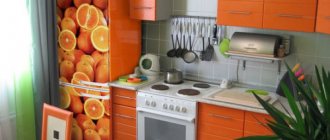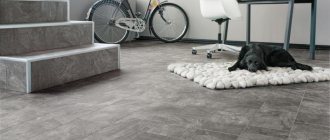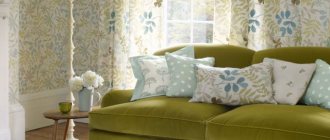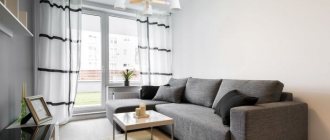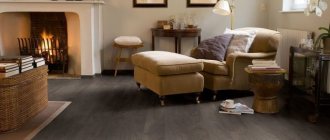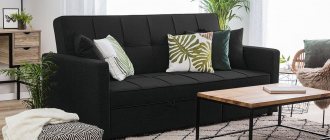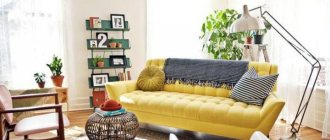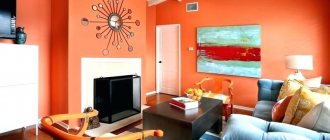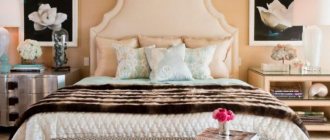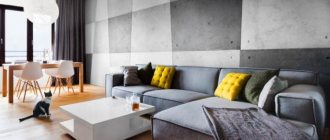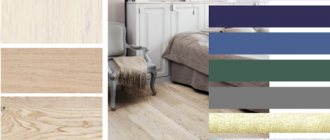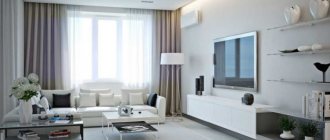The space around us directly affects the mood and atmosphere in the house. Orange color was specially created by nature to bring a “note” of warmth, comfort and cheerfulness to the interior. If the apartment does not have enough sunlight, then this shade will add it to the house, as well as improve the mood and tone of the body and have a beneficial effect on the health of all household members.
Pros and cons of orange in the kitchen interior
Orange is often called orange - and it organically combines the life-affirming energy of impulsive red with the captivating warmth of yellow:
- helps create a pleasant mood even on the most dreary autumn or winter day;
- invigorates and energizes you in the morning, increases appetite and optimism in life;
- perfectly plays “secondary roles” - harmoniously complements the main color scheme, helping the basic shades to better reveal themselves;
- suitable for creating a bright color spot - guarantees richness and expressiveness of the shade;
- there are many variations of orange, each of which is universal in genre and fits into both classic and modern high-tech interiors;
- Suitable for both a very modest room and a decent-sized kitchen - if the intensity of orange is minimal, objects do not visually increase in size, and the original proportionality is preserved.
However, any solution always has a downside:
- if there is a lot of it in the decoration, it can tire and even cause irritability;
- attracts attention, which is especially evident in small kitchens;
- requires increased attention and caution when combined with shades of other temperatures;
- can often seem bad taste - however, this pattern is applicable to all emphatically bright colors.
The disadvantages of using orange in kitchen design can be compensated by its obvious advantages. And if you show the necessary caution and an intuitive sense of harmony, then without any problems you can get an interior verified from a design point of view, in which everything will be in its place - and your eyes will be happy.
Decorative elements
For an orange interior, you can safely choose any decor with a floral and fruit theme. The presence of an elegant bouquet of dry plants or a small herbarium painting of bright autumn leaves will be very useful.
All sorts of bright accessories will add additional charm to the kitchen: household appliances, dishes, textiles, wall clocks. But it should be remembered that orange itself is a bright color, so additional decorative elements should be chosen in neutral colors: black, brown, silver, etc.
Variety of shades
If orange for you is exclusively the color of a ripe orange fruit, then get ready to break the pattern: there are more than a hundred (!) of its shades. They differ not only in color temperature, but also in their influence on the mood in the interior:
- apricot - bias towards pale yellow, zones the space well;
- aurora - lightened orange-pink;
- vermilion - bright scarlet with an orange tint;
- chestnut - reddish-brown;
- coral - pink-orange color, gentle and delicate, universal;
- tangerine - named after the fruit, creates an active, cheerful background;
- honey - between orange and brown, creates a peaceful atmosphere;
- carrot - a bright and joyful shade;
- peach - reddish light orange, better suited for wall decoration;
- orange - a burning and dynamic orange-red, for spacious rooms;
- rusty - dark, red-brown;
- tango - orange with a brown tint, optimal for ethnic interiors;
- amber is a mixture of orange and yellow, very rich and dark.
Orange curtains for appetite
Bright and hot colors are a common design for restaurant halls. This phenomenon can be explained quite simply.
- From the point of view of psychologists, it is the orange palette that has a beneficial effect on appetite, significantly enhancing it.
- Therefore, if your appetite is already excellent, then you should not use orange decorative elements in the kitchen interior.
- They will be unnecessary and to some extent harmful for someone who prefers some restriction in the consumption of “goodies”.
Curtains with bright orange colors are a great way to cheer up someone who has a difficult and sluggish breakfast in the morning.
In this case, it is simply necessary to try this method of “influence”.
You should also not waste your time and nerves trying to persuade your baby to eat “at least a spoonful.” Just add an “orange” mood to your interior. The child will reciprocate with gratitude.
What can you make orange?
Everything. There is only one condition - it is extremely important to maintain the dosage of color in the space and take into account the nuances of the layout. In this case, orange will not aggressively dominate the interior, and your eyes will invariably contemplate strict harmony and a color scheme adjusted to the smallest detail.
Kitchen set
Both the lower facades and the upper cabinets can be decorated in the same color. Orange will look best on a glossy surface. It is good if the facades have characteristic roundings. This smooth geometry better correlates with the orange mood and helps to optimally fit it into the kitchen space.
When there is a lot of usable area, it is advisable to divide the set by color into a darker shade at the bottom - and any of the neutral colors like gray or white at the top. This will make the room seem taller and, accordingly, more spacious. It is better to choose cream or light beige wallpaper for such an orange kitchen, without any pattern.
Designer tips
Irina
founder of the interior studio, architect and interior designer. The main area of work is kitchen design
A very winning combination with an orange set - especially if you are building an interior according to the principles of high-tech and contemporary - is a floor with imitation wood. Usually 15x60 cm dies are used, but if you want more organicity, purchase rectified porcelain tiles. All elements will be laid close to each other, so there will be no annoying seams.
Ceiling
An infrequent decision, especially in the context of the currently popular Scandi and hi-tech. Nevertheless, it looks unconventional and interesting in combination with a snow-white kitchen.
It’s good if you can organize a roll call of such a cheerful ceiling with furniture or decorative elements integrated into the interior.
Choose curtains or curtains that are lighter or darker so that you don’t end up with too many variegated shades.
Curtains
The color of the furniture in an orange kitchen plays a major, leading role. In order not to interrupt this dominance, it is better to choose stylish curtains for the kitchen that are not too bright, such that they will not draw attention to themselves.
Ideally, the color of the curtains should repeat, as if duplicate, the secondary shades of the interior. The same color can be repeated in other textile accessories - tablecloths, towels.
Orange is a very thick, “dense” color; in contrast to such density, the window opening can be decorated with light, airy and translucent curtains.
If you really want to decorate the window in orange, then it is better to make the curtains “match” the color of the furniture set only with decorative elements or a subtle pattern.
What does it go with?
This question always appears after choosing the main color to decorate a particular room. In the case of orange, the space of options is outlined, if not very broadly, then at least with a good margin for your imagination.
With white
The case when it is impossible to lose. Indeed, the neutrality of white combines well with the fervent enthusiasm of orange in all its many manifestations. It is no coincidence that one of the most common combinations in the kitchen is a flashy orange set against the backdrop of restrained white walls.
You can do it differently: decorate one accent wall in orange, and accompany it with the remaining three white ones.
Don't forget about proportions. In small kitchens, the ratio of white to orange should be 3 to 1, especially if we are talking about dark and rich shades like terracotta or pumpkin.
With black
This vigorous combination guarantees your kitchen a special sophistication and gives every centimeter of its area a unique thick and viscous atmosphere. But only if an experienced and talented designer actually worked on the project: here there is a subtle game on the verge of a foul, a step to the left or to the right - and now you are already dealing with suffocating bad taste.
Therefore, some third companion color is often used as a saving straw. For example, white or beige.
Possible options:
- black and orange set against a background of light beige walls;
- black ceiling and walls with orange furniture;
- orange kitchen with black countertop.
With brown
Most often, orange is friends with brown in rooms decorated in a classic style. Since both colors are warm, they are great for creating a homely atmosphere in neat pastel colors.
There are a lot of compilation options. For example, make the base brown and paint 3 walls with it, and decorate the 4th as an accent wall. Accordingly, the remaining elements are selected in calmer shades to avoid possible color confusion.
Another winning way to interact is with brown furniture. This includes not only the kitchen set, but also the entire dining set. You can use orange to decorate the apron, add the floor to it, and also place bright accents around the perimeter. Give preference to red or peach - they are not so intense and will help create the right interior harmony.
Finally, don’t forget about the richest brown options - dark coffee and chocolate. In the right proportions, they perfectly balance bright orange tones and bring homeliness to the room.
With gray
Everything is logical: the variegated orange color is muted by a neutral gray background. This way the atmosphere in the room becomes calmer and even peaceful.
Orange goes well with the entire gray group: from classic light to deep anthracite.
You can often find a kitchen set with this combination. It looks especially impressive if it is finished with chrome elements and contains glass inserts.
With beige
Be careful with this mix: if you indiscriminately combine beige with orange, you end up with a completely gloomy and boring kitchen in which you are unlikely to want to spend much time.
It is ideal to use light beige walls and bright orange furniture. Additionally, you can again scatter colorful spots in the form of decor or kitchen utensils. Or, as an option, use orange to decorate your dining room. In any case, the situation is extremely clear: beige is the main color, and orange comes into play, creating a cheerful orange mood on the peaceful beige base.
With blue
An unusual combination typical for ethnic interiors. In particular, for the Mediterranean style, which welcomes bright colors and a non-trivial color oxymoron.
This mix greatly refreshes the interior, adds maximum light to the room and, moreover, makes small kitchens more spacious. An illusion, of course, but from a visual point of view everything is in perfect order.
Pumpkin or carrot shades go best with blue. Which of the pair to choose as dominant is up to you to decide. Remember that if there is still more orange, the room will sound warm and homely.
The apron is usually decorated in blue. It is especially advantageous if decors are used to decorate it.
With green
This combination is best used in cases where there is no need to calculate the usable area. In a spacious kitchen, green and orange tones create a beautiful and unobtrusive mood.
The intensity is adjusted by choosing the desired shade. Want pastel colors? Take classic green as a decoration for the set, and use a paler apricot as a background.
If you prefer a brighter range, then the light green-tangerine combination will enliven the space, but will require the introduction of a companion in order to muffle the overly flashy tones in some places.
The green apron looks very advantageous against the background of the orange facades of the kitchen set.
Selection of furniture and equipment
For a bright and unique design, install a modular set with a matte or glossy facade in tangerine or pumpkin colors. Models with gray or white doors and orange side walls look less flashy, but at the same time quite attractive. You can further emphasize the beauty of the orange palette with wenge-colored furniture elements, complemented with metal fittings or aluminum edges.
An excellent solution is a table and transparent chairs made of plastic. Depending on the interior style, the dining group can also be made of natural wood.
The photo shows an orange kitchen with an island complemented by transparent bar stools.
As an accent, you can choose a sofa with bright upholstery or install custom appliances in the form of a carrot refrigerator, complementing a bright apron or dining area.
In what style is orange appropriate?
We have already noted above that there are no style restrictions here: orange fits perfectly into strict classical interiors, and is perfectly revealed in expressive Mediterranean designs, and even harmoniously integrates into ascetic Scandi and hi-tech.
But under one condition - the correct intensity of the shade and its moderate dosage in space.
Let's take, for starters, modern popular design styles. For example, Scandinavian minimalism. Orange is introduced here in portions as bright color spots.
Or as a color for facades. It’s great if the headset has chrome parts and glass elements - this combination guarantees an original appearance, while the philosophy of modern high-tech style does not suffer at all from such a mix.
But for Provence and country, choose calmer shades of orange. Chestnut, mustard or honey shades are welcome - they look great against the background of the wooden texture characteristic of these design styles.
It is best to add not flashy orange to the good old classics, but a version of it with some shares of brown. This is a proven design technique that allows you to combine an expressive shade with the warmth and tranquility of a natural wooden surface.
In ethnic designs, bright orange is a frequent guest. This is characteristic of both the Mediterranean style, which has recently been gaining momentum, and African interiors, which are still rare among us.
Interesting options for orange facades
As a rule, it is the kitchen set that sets the orange character of the room. But plain furniture is rarely interesting enough. It is diluted with a design or pattern on the apron, a photo on the skin, or the original decoration of the facades themselves.
- The most commonly combined colors are: The top or bottom of the furniture, checkerboard doors, or just a couple of cabinets are painted in the selected companion shade, and then the same tone is used for the dining area or decor and dishes.
- To complete the composition in a modern kitchen, you can use the edging of the facades in a gray-metallic tone. The gray-orange duet is typical for a technological interior. But it must be complemented with another bright color that can decorate the skins, facades, top or bottom of furniture. This is the optimal technique for creating a harmonious composition, even in a large apartment, even in a Khrushchev-era building.
- Contrasting solutions are organic when two primary colors are used in the design of furniture and the entire kitchen, one of which becomes a pattern on some surfaces and a background on others. The photo shows that golden orange (orange) complements wenge in the decoration of part of the facades, and the light brown ornament on the apron goes well with the set.
You can find many options for original combinations. Whatever duets and color trios are chosen, it is important to choose techniques for combining them. To decorate a kitchen both in a Khrushchev-era building and in a private cottage, you can use light wenge accents, in gray and black tones, and in metallic colors. When used in finishing the rest of the room, they will make the composition complete and the kitchen set harmonious.
Which apron to choose?
Since orange itself, even in versions with minimal shade intensity, perfectly attracts attention, the apron should be finished in any neutral shade:
- classic snow-white;
- soft cream;
- light gray;
- creamy;
- light beige, etc.
This is provided that the fronts of your kitchen unit are painted in the typical bright orange color.
There is another way, not so common and more risky - choosing a darker and deeper shade. In this case, you can get a non-standard combination that gives your interior special expressiveness and individuality. For example, black or brown. The result is a bright combination that greatly emphasizes the extraordinary taste of the apartment owner.
What about texture? The ubiquitous marble stains do not go well with catchy orange facades, so it is better to opt for segmented tiles or skins with a thematic pattern.
If you want it to look “expensive and rich,” try glass mosaic. It is sold in construction stores in fragments of 30 by 30 cm and can be easily torn off along the grid. It will turn out really impressive, but be prepared for difficult care: washing such small pixels from grease, soot and dirt is not much fun.
What wallpaper is suitable?
The choice primarily depends on the color of the furniture, for example, it is better to choose wallpaper to match the orange color of the kitchen set in white, pistachio, beige, sand or blue tones. Canvases in milky shades significantly soften the orange color.
The photo shows the interior of an orange and white kitchen with plain yellow wallpaper.
To create a modern and fashionable design with a cozy atmosphere, wallpaper in gray tones is appropriate. For those who appreciate luxurious, expensive and chic design, ivory-colored products are suitable.
In a small kitchen in a Khrushchev-era building, it is better to cover the walls with light wallpaper or canvases printed with thin orange lines. This way you can create a harmonious environment and a laconic design.
The photo shows an orange island kitchen with an accent wall covered in black patterned wallpaper.
Small kitchen in orange
If every square meter counts, you should be extremely careful when incorporating orange into the interior. By itself, it is excessively intense - and even the most modest excess of it will invariably cause ripples in the eyes. In addition, in its most striking manifestations, it tends to increase objects in size.
What to do if you really want to see this cheerful and optimistic shade in your kitchen?
As an option, decorate only one wall in orange. For others, classic beige or white is perfect. Color harmony is guaranteed, and as a bonus, the ceilings will appear higher.
Find more interesting ideas for decorating a small kitchen here.
You can also try partially painting the walls. For example, up to the level of the apron or dining table. Again, give the top a white, gray or any other calm shade. As a result, even a very cramped room will seem more spacious - and the orange color will not interfere with this at all.
Finally, you can simply introduce orange in the form of decoration or minor details. Thanks to their intensity, even the smallest accessories will be noticeable - and the overall color scheme of the kitchen will become much more interesting and multifaceted.
Common Mistakes
What to avoid when designing a black and orange kitchen.
- When additionally decorating the kitchen, you should not choose bright color accents of a warm palette - red, raspberry, lemon. The fact is that orange color can mute any shade located on its background, and therefore, instead of an accent, we get an element that will “argue” with the background, creating disharmony in the interior. It is better to play on the contrast of warm-cold shades.
- Even in the most daring interior there is no need to use a black ceiling. It will make the kitchen a room with a heavy depressive atmosphere. It’s also not worth making a multi-level multi-colored ceiling, since the kitchen interior is already overloaded with a large number of details due to its functional purpose.
- Large kitchens do not tolerate a clear division into a dark bottom and a bright top, or vice versa. In such cases, the interior looks boring and not original. To correct the situation is very simple - you need to dilute the orange with black, and the black with orange.
- When decorating a kitchen-dining room, it is not advisable to make both zones in the same color scheme. It is better to separate the dining area with a bar counter or a difference in floor height, and use a different, calmer combination of colors in it.
- In a studio apartment, such a bright, exciting option for kitchen design should not be used. But if you really want to, then you need to think about a sliding screen that separates the “screaming” kitchen from the calm living room.
Orange kitchen-living room
The combination of two functional rooms into one most often occurs in the case of a lack of usable space - or, conversely, when there is a complete excess of it.
In the first option, this is typical for small studio apartments in a combined layout format. In the second - for private houses, made according to an individual plan in strict accordance with the wishes of the owners.
One way or another, both formats are characterized by the use of orange color for finishing the furniture group. This includes a kitchen set, a seating area with a soft corner, and dining sets with a table and chairs in a single concept.
Another way to play up orange is to use it to decorate your backsplash. It will be a bright spot of color in the room, but it will be properly dosed, so it will never get boring.
Take a unique approach to the design of curtains. If the room is large, then choose duller shades of orange, otherwise your eyes will get tired quickly.
Textiles in orange tones
Curtains or a small rug under your feet will add a note of warmth to the interior if you want to see a bright accent in your home, but are not ready for drastic changes. Buying an orange kitchen set is a responsible step; such furniture is purchased once every decade, so you can start adding orange color to the design in portions. Bright details will allow you to determine for yourself whether to enhance the effect or limit yourself to small elements of a sunny tone in the interior. At the same time, the rug and curtains can be easily replaced if necessary.
Photo gallery
If the walls are orange
Orange wallpaper in the kitchen requires careful selection of kitchen furniture, because the rich orange color requires a harmonious composition. As a rule, one of the walls or an area around the perimeter is painted in such bright colors. A pumpkin shade can serve as a background for the open shelves of the work area. Then the furniture should be less bright:
- white;
- cream or beige;
- pastel green;
- pale blue;
- light woody.
When choosing wall decoration in peach tones, you can give preference to a more saturated set. It is appropriate here to use chocolate or wenge facades, black surfaces, bright green and blue solutions. The white color still remains harmonious, which can be noted in the photo.
How to use color combinations correctly
Listed above are the shades next to which our sunny color looks most advantageous. Let's take a closer look at how to apply colors most successfully.
1. Black adds elegance to orange and makes it stand out even more. However, this design is only suitable for medium or large kitchens. In a small kitchen, it is better to use black to a minimum so that it does not “eat up” the space: for example, make individual parts of the kitchen cabinets black. In a black and orange kitchen, we recommend using very light wallpaper for the walls and light materials for the floor. Such compositions look very impressive, which can be seen in the photos of ready-made design solutions.
2. Wenge color emphasizes the beauty of orange shades, but does not make them flashy. One of the options is furniture in the dining area in wenge tone, which will look very good in a classic-style kitchen. This design can be complemented with metallic and silver shades (metallic tabletop, aluminum edge), which adds a touch of modernity.
3. If you want to use blue, then choose its warm shades (they are darker). In the photo you can see that professionals often complement such solutions with light walls and a light floor - then the kitchen looks more “airy”.
4. The combination of orange and green is an option that has already become a classic. The following rule applies here: if the orange is bright, then the green should also be saturated. If peach or pumpkin tones are used, then the shade of green is taken to be more muted and soft. You can look at our selection of photos of interiors with different combinations of green and orange tones. Combined facades made in these two colors look great. In this case, wallpaper for the walls is suitable in a neutral color, for example, cream.
1 of 15
5. Another option is orange wallpaper for the walls, which is combined with furniture of another suitable shade.
